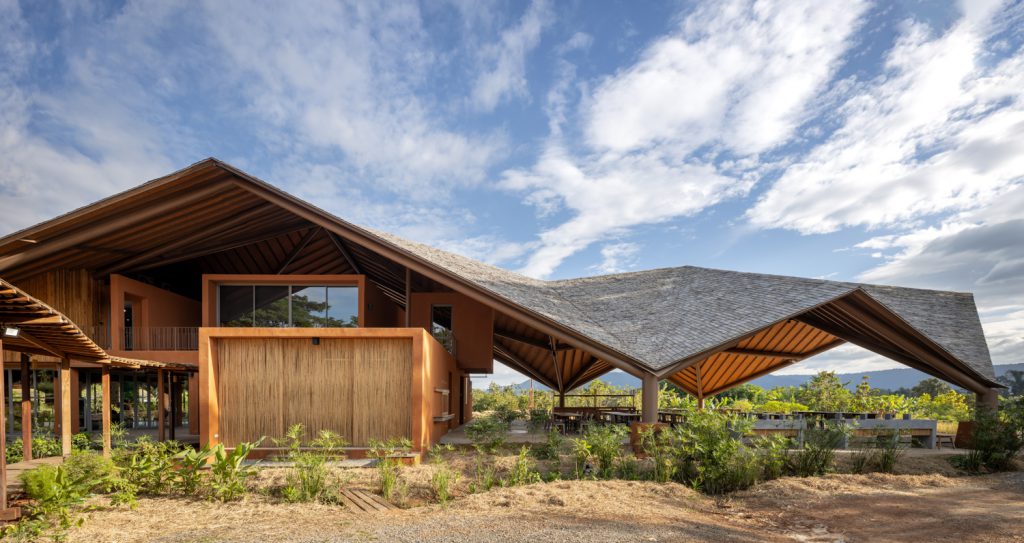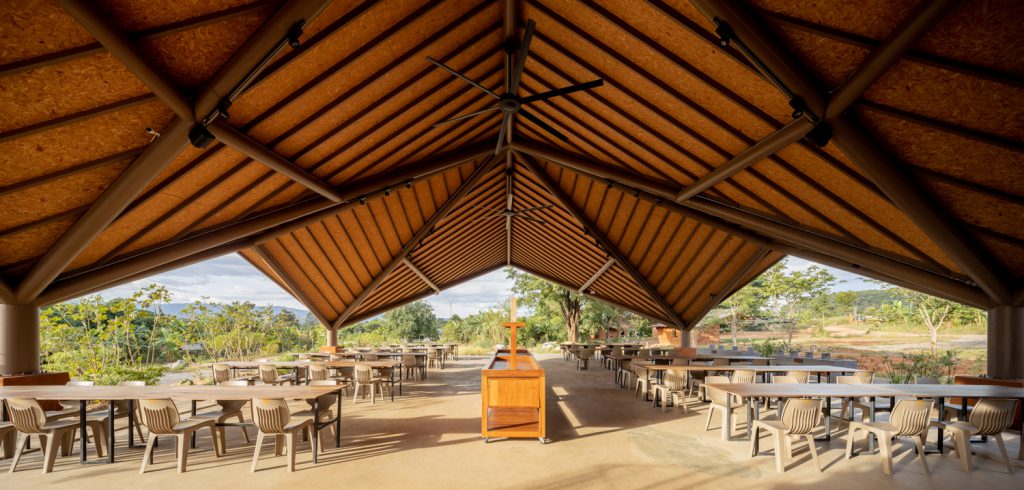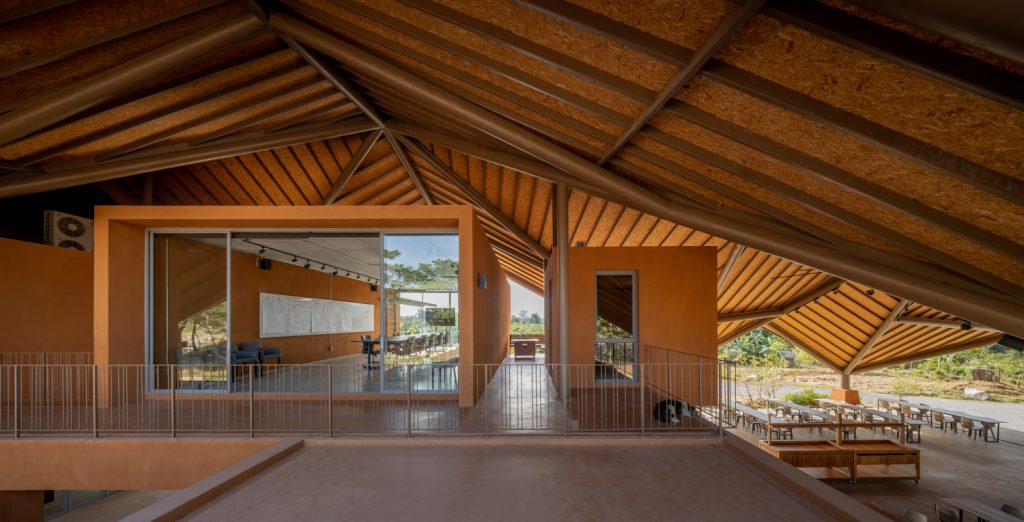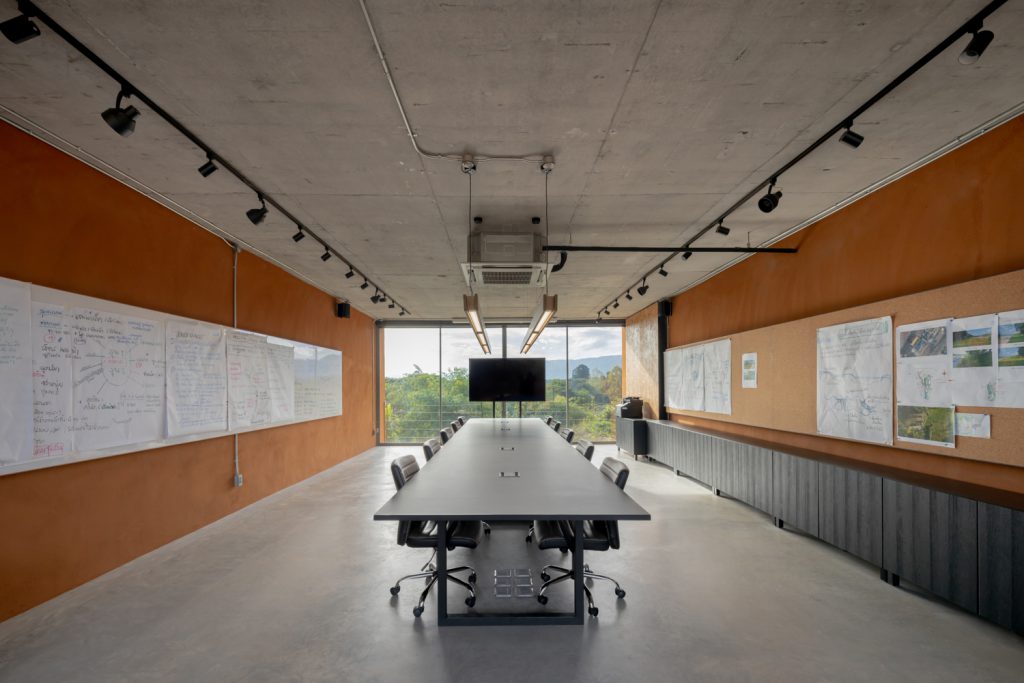In designing this new learning center in Khao Yai, Vin Varavarn Architects has demonstrated that local craftsmanship and local materials can become involved and transformed to create an attractive modern architecture.
Text: Xaroj Phrawong
Photo Courtesy of Vin Varavarn Architects and Ketsiree Wongwang except as noted
Download the online journal Issue 04 Towards Circular Living Click here

สถาปัตยกรรมนอกจากที่จะทำหน้าที่ยกระดับคุณภาพชีวิตผู้คนแล้ว ในปัจจุบันมีเรื่องที่ต้องกังวลเพิ่มขึ้นคือการคำนึงถึงที่มากว่ากว่าจะเกิดสถาปัตยกรรมงานหนึ่งขึ้นมานั้น ได้เบียดเบียนโลกเราไปมากเท่าไร แนวคิดเรื่องให้สถาปัตยกรรมลดการเบียดเบียนโลกไม่ใช่เรื่องใหม่ มันเคยเกิดความกังวลในการใช้พลังงานในอาคารจากวิกฤติน้ำมันในปลายศตวรรษที่แล้ว จวบจนปัจจุบันได้มีการคำนึงลึกไปถึงแหล่งที่มาของวัสดุที่ประกอบขึ้นมาเป็นสถาปัตยกรรมด้วย แนวคิดเรื่องการออกแบบยั่งยืนได้ถูกนำเสนอผ่านการออกแบบหลายงาน ประเด็นหลักที่ถูกพูดถึงเสมอเป็นเรื่อง การใช้วัสดุที่มีผลกระทบต่อสิ่งแวดล้อมน้อย ให้เลือกใช้วัสดุที่เป็นพิษต่อสิ่งแวดล้อมน้อย สามารถนำกลับมาใช้ใหม่ได้ ซึ่งสัมพันธ์ไปถึงการออกแบบที่สนับสนุนให้นำวัสดุใช้แล้วกลับมาใช้ใหม่ และการีไซเคิล เรื่องเหล่านี้ควรถูกนำมาหลอมรวมเป็นเนื้อเดียวกันสำหรับการออกแบบในศตวรรษนี้ ท่ามกลางสิ่งแวดล้อมที่เลวร้ายขึ้นมีความพยายามหลายรูปแบบที่จะนำเสนองานออกแบบเพื่อสิ่งแวดล้อมที่ดีขึ้น เช่นกับโครงการที่นำโคก หนอง นา โมเดล มาใช้ คือการนำเสนอการวางผังสมบูรณ์ตามอุดมคติให้สามารถเลี้ยงตัวเองได้ การวางผังนี้ถูกนำมาปรับใช้กับโครงการศูนย์เรียนรู้ศาสตร์พอเพียงพรรณา เขาใหญ่ นครราชสีมา ภายในโครงการประกอบกลุ่มอาคาร ทั้งส่วนอบรมต่าง ๆ ส่วนพักอาศัย โดยมีอาคารฝึกอบรมหลักเป็นศูนย์กลางกิจกรรมให้กับศูนย์เรียนรู้ศาสตร์พอเพียงพรรณา ออกแบบโดย Vin Varavarn Architects

การเข้าถึงโครงการต้องผ่านถนนหลักจากถนนทางไปเขาใหญ่ ทั้งจากถนนธนะรัชต์ และฝั่งตำบลหนองสาหร่าย จากนั้นมุ่งตรงไปตำบลหมูสี ที่ต้องผ่านถนนท้องถิ่นเต็มไปด้วยไร่ข้าวโพด ไร่มันสำปะหลัง สลับกับรีสอร์ตเป็นระยะ จนมาถึงถนนเทศบาล หลังคาทรงแหลมแหวกออกมาจากยอดต้นข้าวโพด ทำให้สังเกตว่ามาถึงศูนย์เรียนรู้ศาสตร์พอเพียงพรรณา จากถนนหลัก ผ่านซอย จึงมาถึงทางเข้าหลักของศูนย์ จากนั้นเดินทางผ่านวงเวียนต้นมะขามขนาดใหญ่ จนมาถึงหลังคาไผ่สีน้ำตาลแหลมพุ่งเป็นจุดรวมสายตา ทั้งรูปทรงหลังคา และตัวอาคารสีส้มแลดูโดดเด่นมาจากยอดไม้สีเขียวโดยรอบ เมื่อดูผังของอาคารศูนย์เรียนรู้ศาสตร์พอเพียงพรรณา พบว่าลักษณะการวางผังแบ่งเป็น 2 ส่วนหลัก คือส่วนอาคารกิจกรรมหลักทางทิศใต้หรือที่เรียกติดปากสำหรับผู้คนในศูนย์ฯว่าอาคารใบไม้ และห้องน้ำทางทิศเหนือ ทั้งสองส่วนคั่นด้วยลานกิจกรรมกลางแจ้ง รายล้อมด้วยภูมิทัศน์ที่ถูกปรับตามแนวคิดโคก หนอง นา โมเดล ลักษณะที่ดินมีความลาดเอียงทั้งไซต์จากทิศเหนือลงไปทิศใต้ ทำให้น้ำไหลผ่านไปรวมยังคลองลำตะคองด้านล่างอาคารกิจกรรมหลักรองรับกิจกรรมทั้งการอบรม มีโถงสูงด้านทิศตะวันตกรองรับกิจกรรมเอนกประสงค์รวมทั้งปรับเป็นโรงอาหารได้ ส่วนกลางอาคารเป็นสำนักงาน ชั้น 2 เป็นห้องประชุม พื้นที่ส่วนตะวันออกเป็นห้องประชุมขนาดใหญ่ ส่วนใช้สอยแต่ละส่วนออกแบบให้แต่ละมวลทำหน้าที่โดยแยกออกจากกัน หลังคาพับทำหน้าที่ปกคลุมทุกส่วนใช้สอยทั้ง 2 ชั้น หลังคาทำหน้าที่คลุมแยกออกจากกลุ่มก้อนอาคาร ผืนหลังคาออกแบบเป็นจีบพับไปมาในโครงสร้างเหล็กระบบเฟรมวางบนเสาเหล็กกลมทั้ง 8 ต้น รูปทรงที่พับไปมา มุงด้วยไผ่สีน้ำตาล เป็นที่มาของชื่ออาคารใบไม้ จากการออกแบบที่ให้มวลอาคารแยกออกจากหลังคา เกิดช่องว่างปริมาตรใหญ่ใต้หลังคา ประกอบกับการยกใต้ถุนสูงบางส่วน ทำให้อากาศพัดผ่านอาคาร ก่อเกิดการไหลเวียนของอากาศเป็นอย่างดี ลดการใช้พลังงานในส่วนของการปรับอากาศ โดยเฉพาะส่วนโถงสูงที่เปิดโล่ง 3 ด้าน แล้วติดตั้งพัดลมเพดานขนาดใหญ่จำนวน 2 ตัว เพิ่มการไหลเวียนของอากาศ รับกับกิจกรรมหลายอย่างของทางศูนย์ฯ ที่ไม่เหมาะจะใช้ห้องปรับอากาศ
ทางทิศเหนือของอาคารกิจกรรมหลักคือส่วนห้องน้ำ เนื่องจากการใช้สอยในศูนย์ฯเน้นให้เลอะได้ ก่อนเข้าจึงมีการเตรียมพื้นที่ส่วนล้างจากการเลอะดินโคลนก่อนเข้าไปยังภายในห้องน้ำ เนื่องจากที่ตั้งเป็นดินเชิงเขาใหญ่ การใช้งานย่อมมีการเปื้อนดินโคลนอย่างหลีกเลี่ยงไม่ได้ การออกแบบมวลอาคารแยกส่วนผนังออกจากหลังคา ทำให้ดูเบา ลดความตันจากการที่เป็นผนังทึบตามการใช้สอย เพิ่มการไหลเวียนของอากาศพื้นที่ใต้หลังคาได้ดี ลดการใช้พลังงานไฟฟ้าในเวลากลางวันด้วยการดึงแสงธรรมชาติเข้ามาจากหลังคาโปร่งแสงที่สันหลังคา ผังแบ่งออกเป็น 2 ส่วนคือห้องน้ำหญิง และชาย ลักษณะเป็นผนังก่ออิฐมอญโค้ง 3 มิติ แบ่งทางเข้าเป็น 2 ฝั่งตรงข้ามกัน ส่วนที่น่าสนใจคือการใช้ผนังก่ออิฐโค้งไล่เป็นโค้งแบบ 3 มิติ การก่ออิฐเป็นการก่ออิฐแบบผสมทั้งทึบในส่วนที่ต้องการความเป็นส่วนตัวเพื่อบังส่วนอาบน้ำ ห้องส้วม โถปัสสวะ และก่อกึ่งทึบกึ่งโปร่งในส่วนทางเข้า การก่ออิฐโค้งกำหนดความโค้งจากโครงเหล็กแฟลตบาร์ตัดเป็นโครงโค้งไล่ไปตามแนวแปลน และเหล็กนี้ยังทำหน้าที่ยึดผนังทั้งในแนวตั้งและแนวนอนด้วยการแทรกอยู่ระหว่างแผ่นอิฐ
แนวคิดเรื่องการวัสดุที่หาได้ใกล้ที่ตั้ง ลดภาระการขนส่งคือการใช้ผนังฉาบด้วยดินจากในที่ดินมาร่อนจนละเอียด ผสมเข้ากับน้ำยาประสานให้ยึดเกาะกับผนังก่อได้ดี ผนังดินฉาบนี้ถูกใช้เป็นส่วนหลักทั้งภายในและภายนอกของอาคารกิจกรรมหลัก และภายในอาคารห้องน้ำ ผลลัพท์ทำให้มีผิวอาคารที่มีความหยาบ ความงามแบบช่างฝีมือชาวบ้าน ไม่เนี๊ยบแบบวัสดุอุตสาหกรรม และมีเรื่องราวยึดโยงกับถิ่นที่ ด้านแนวคิดเรื่องการใช้วัสดุหมุนเวียนได้ถูกนำเสนอด้วยการใช้ไผ่มาเป็นวัสดุหลักที่มุงหลังคา แม้ว่าจะเป็นวัสดุที่ทำให้มีความกังวลจากอายุการใช้งาน สถาปนิกได้เสนอให้ใช้แตกต่างจากวัสดุในท้องตลาดที่ดาษดื่น ในที่สุดได้เป็นหลังคาไผ่สับฟาก วิธีการนำไผ่มาใช้มาจากเจ้าของจัด มีการปลูกไว้ในโครงการ ทำให้ลดการขนย้ายไกลจากที่ตั้ง เทคนิคการนำไผ่มาใช้ส่วนสำคัญคือการป้องกันปัญหาแมลงเข้ามากินแป้งในไผ่ ซึ่งมีวิธีการป้องกัน 2 แบบ คือใช้สารเคมี และการไม่ใช้สารเคมีที่ทางงานนี้ได้เลือกใช้ เทคนิคแบบนี้มีทั้งทำให้แป้งหายไปทั้งการต้ม เผา แต่วิธีเหล่านี้มีข้อเสียถึงการใช้พลังงานในการทำ วิธีที่ใช้กับงานนี้คือการทำให้แป้งในไผ่เน่าจากการแช่ไผ่ในน้ำ โดยการแช่ในลำตะคองด้านทิศใต้ของโครงการเป็นเวลาหลายเดือน ก่อนนำมาใช้งาน เป็นวิธีที่ง่าย ประหยัดสุด มากกว่าวิธีเผาให้แป้งหายไปด้วยความร้อน หรือการใช้น้ำยาสารเคมี เมื่อไผ่ได้แช่จนอายุพอแล้ว จึงนำมาสับให้แบน ติดตั้งบนไม้ OSB พร้อม sub roof แล้วทาด้วยน้ำยาเคลือบไผ่ เมื่อหลังคาไผ่หมดอายุการใช้งาน ก็สามารถบำรุงรักษาด้วยหลังคาไผ่ชุดใหม่ที่ปลูกรอไว้ แล้วดำเนินการตามกระบวนการเหล่านี้อีกครั้งโดยลดการใช้วัสดุอุตสาหกรรมจากนอกพื้นที่
หม่อมหลวงวรุตม์ วรวรรณ สถาปนิก และผู้ก่อตั้ง Vin Varavarn Architects ตอบถึงเรื่องการออกแบบที่สอดคล้องกับสภาพแวดล้อมว่า “ในแง่ของการออกแบบยั่งยืน ผมมองในแง่ปรัชญา เราพูดถึงต่อไปในยุคอีก 20-30 ปี ถ้าโครงการนี้ ศาสตร์นี้ยังอยู่ สถาปัตยกรรมก็ไม่จำเป็นต้องเป็นแบบนี้อีกแล้ว มันสามารถพัฒนาเพื่อสอดคล้องกับวิถีชีวิต สถานที่ การใช้งาน ของคนในยุคอนาคตมากขึ้น”
Apart from its significant purpose of lifting the human standards of living, the architecture of the present-day also needs to address its impact on the environment. The concept of environmentally friendly architecture or architecture that ‘touches the earth lightly’ is not new, as there have been more and more concerns about energy consumption that stemmed from the oil crisis late in the last century. Today, there are additional concerns regarding the source of the materials used in architecture as well as the materials used.
Sustainable design can be seen through many works and most of these are about utilizing materials that reduce the impact on and harm to the natural environment. Emphasis is now on recyclability, and reusability, which relates to designs that support the reuse of materials. These concepts are applied hand-in-hand to current 21st-century designs, amidst a worsening environment. There have been many experiments related to design that could improve the environment by lessening the impact. One such effort is adapting the Khok Nong Na model, ideal agricultural planning that allows the land plot to sustain itself. This model is applied to the Pannar Agricultural & Sufficiency Science Learning Center at Khao Yai in Nakhon Ratchasima province designed by Vin Varavarn Architects. The project is a built complex of learning centers and rest areas, with the main training center being the focus for activities.

In approaching the building, visitors must pass through the main roads that reach Khao Yai, being either the Tanaratch road or the roads from Nong Sarai before heading straight to Moo Si district, whose local roads are full of corn and cassava fields along with some resorts to reach Thetsaban road. Here, seeing a pointed rooftop perching from the cornfields means that one has reached their destination the ‘Pannar Learning Center’. The main entrance can be reached after going through the main road and alley. Driving past the large tamarind roundabout, visitors will see an elevated pointed brown bamboo roof and an orange-colored building standing apart from the green surrounding scenery. The learning center has two main parts, the first is the main activity building to the south, commonly known as the leaf building, and the second is a series of restrooms to the north. Both parts are separated by the outdoor activity area and surrounded by purposeful landscaping intended to fit the Khok Nong Na model. The entire site slopes down from the northern side to the south with the site’s stream running into the Lam Takhong canal below.
The main activity building covers a range of utilities, including teaching and learning functions, dining area, office, and business space, and conference functions. Each usable space is partitioned separately from the others and used for its designated purpose. The atrium on the west side of the facility is used for general activities and can be adapted into a secondary dining hall. The center of the building serves as the office area. The 2nd floor is used as a meeting room and the eastern part serves as the major conference area. The folding roof covers all utility spaces of each floor and can be isolated from the building mass. As its name implies, the roof is designed as a folding and asymmetric steel frame structure supported on eight circular-shaped steel pillars. The brown bamboo ‘Leaf’ is a term derived from the roof’s ability to fold, its color, and its material.
The design concept of the roof being able to separate from the building provides for a large volume of space within the building. This concept combined with raised floors in some parts allows the air to flow through the building effectively and naturally without the need for mechanical air conditioning intervention which in turn reduces the building’s energy consumption. Additionally, the atrium which has three opened sides combined with the large ceiling fans provides an internal environment suitable for most of the center’s activities without the need for air conditioning. As noted previously, the center’s restrooms are located north of the main activity building. As the Center is located effectively on a raised dirt mound, it is inevitable for users to become dirty during their activities. Spaces are therefore provided for cleaning oneself before using the restrooms.
The design of the building mass separates the roof structure from the walls giving the building a sense of lightness while ventilation is efficiently enhanced in the spaces under the roof. The translucency of the roof allows for the penetration of natural light thus reducing the dependence on artificial lighting systems and electrical consumption in the daytime. The building’s floor plan is separated into two parts, one each for male and female users. Partitioning is a three-dimensional curved clay brick wall used to separate the entrances for each sex on opposite sides. The wall is composed of both dull and opaque brickwork providing privacy and is measured by the curved flat bar steelwork that is dissected into the curved structure perpendicular to the plan. The integrated steelwork is placed between the bricks and is used to hold and support the wall, both vertically and horizontally. The environmental concept of renewable materials is applied using bamboo as the main roofing even though there is some concern about the materials’ durability. The architect proposed a material that is not ubiquitous in the market, and thus bamboo mat was used. The sustainable bamboo is supplied by the project’s owner and is grown on-site negating any possible logistical issues that may be associated with supply and transportation.
The prevention of insect attacks was resolved using non-chemical-based treatment. Boiling and burning of the bamboo were initially considered but the disadvantage of this technique was the amount of energy use this would require. Therefore, the architect chose instead to soak the bamboo in water to foul the flour. The material was soaked in the Lam Takhong canal for months before use. This was deemed the most efficient and cost-effective method compared to burning or the use of chemicals. After sufficient soaking, the bamboo was flattened and installed on OSB wood along with the sub-roof. Roofing is replaced after the initial material degrades and is a sustainable methodology reducing the need for the use of industrial-grade materials.
When asked about design that is suitable for the environment, ML Varudh Varavarn, architect and founder of Vin Varavarn Architects said a “I view sustainable design through a philosophical lens. If this design and knowledge are still there in the next 20-30 years, it would not be necessary for other types of architecture. The design can be developed to fit the way of life, places, and utility of the future generation better”.









